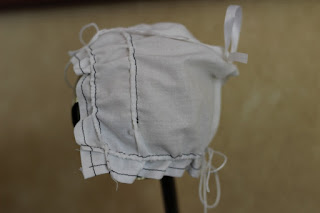I've been wanting to make a new cap for the baby out of better fabric (lawn instead of muslin). I even learned some new hand-sewing techniques at Liz Clark's day cap class that I've been wanting to try out. So, I went to the Workwoman's Guide and found this Poor Infant's Cap. Actually, I gave it that name; it doesn't even have a name in the book. It was really easy, but it is REALLY small---probably for a teeny-tiny baby! So, I'm really glad I did a muslin test run first because it definitely won't fit my 14-month old. As a larger size was not given, I'm not sure that this kind of cap would be used for an older baby.
In my test-run, I used contrasting thread so you can see where I ran my stitches. Here's how I did it, with both the original instructions and my interpretation.
Original: PLATE 2 FIG 12 13 This is much used by the poor, and is easily made and as easily washed.
Original: Take of the material a piece 6 nails down the selvage and 3 1/2 nails wide.
Translation: Cut a piece along the selvage 13.5" by about 8" (my picture does not follow the selvage; it should be cut the other direction).
Original:
Double it, letting D be the doubled part.
Translation: Fold it in half.Original: Sew up the back from A to C leaving a small hole or button-hole at the top C;
Translation: With right sides together and your fold at the top, stich down one side to form the back of the cap leaving a small gap at the very top (next to the fold) and another small gap half way down.
Original: make a runner all round the front and behind, at half a nail's distance from the edge, which is hemmed with a very narrow hem to form a frill; also lay in a runner from E to F;
Translation: About 1" in from the edge on the right side of the fabric, sew a small casing along the bottom and front edges of the cap. Sew another casing along the front edge of the cap about about 1 1/4" in from the first casing, stopping a little over an inch above the bottom edge of the cap on either side. Sew a narrow hem along the front and bottom edges of the cap to form a frill. (The frill is very minor. If you cinch up your strings to make more frill, the cap is even tinier!)
Using a blunt needle, run 6 strings through your casings securing one end (see top drawing and below picture for placement). If you are hand sewing, I'd just hand sew my strings into my casings as I go.
Original: next, sew a bobbin at B, letting one end of the string hang outside and the other being pulled through the seam, remains inside the cap. This end is carried up and brought out through the hole at C (see the dotted line in the Plate which represents the top inside); when worn, the tapes, on being tied together at B, draw up the cap into shape, and if neatly arranged and pulled out with the fingers, it looks very neat and pretty. (See Fig 13) Some put a loop of bobbin inside at B, which on being brought out through C, fastens to a button at B, on the outside.
Translation: Run a tape (I used a ribbon) through the little holes you left in the back of the cap. Secure one end at the back center; pull the other end to tighten up the back. Tie the ties together to keep the shape. You can also put a button on the outside of the cap where you can secure your long tie. For ease, I just left two long ties and tied a bow.Add chin ties.






2 comments:
Good job with the translation from old to new! It does make a tiny cap, but could be enlarged as needed for slightly older babies, too.
I also think your noggin hand-model is sweet. :)
I can't find the "contact" info, so will post a link that appears to me down/non fuctional.
"I was browsing Elizabeth Stewart Clark's forum and stumbled upon this: http://www.theyoungcampaigner.com/2007/10/make-your-own-m.html"
Post a Comment